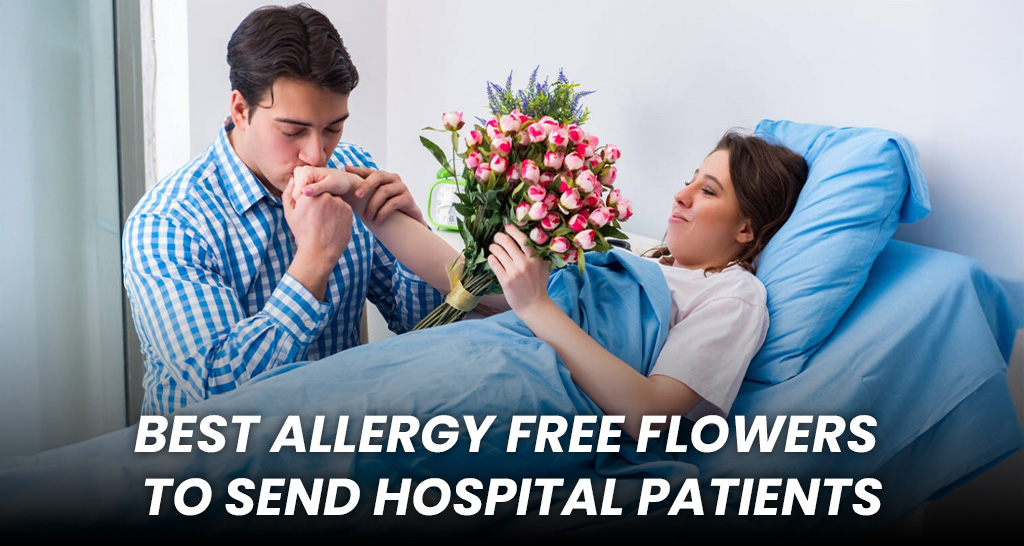
Best Allergy-Free Flowers to Send Hospital Patients
Orchids, Roses, Hydrangeas, Tulips and Carnations are the best flowers for patients and people with allergies. Whereas Lilies, Sunflowers, Daisies, and Chrysanthemums are not recommended for hospital deliveries.
Sending flowers to someone in the hospital is a meaningful way to show support and care, with messages ranging from “Get well soon” to “I love you.” Flowers can also brighten the hospital room and boost the patient’s mood. You should consider a few things when sending a bouquet of flowers to a hospital patient. It’s important to be mindful of allergies and hospital restrictions by choosing allergy-friendly or low-pollen flowers.
Flowers symbolize care and concern during hospital visits, helping to lift the spirits of loved ones. Choosing the right get-well flowers can improve mood and aid in recovery.
This guide covers the best and worst flower bouquet for hospital patients and why, tips for delivery, and how to seamlessly send flowers to hospitals from the best online flower shop in Oman.
Why Some Flowers Not Allowed in Hospitals?
It’s important to understand hospital guidelines regarding flower deliveries to patients. Some departments, like ICUs, prohibit flowers entirely. Many hospitals have rules in place for health and safety reasons.
- Allergies and Sensitivities: Many patients have pollen or fragrance allergies. So, be careful to choose the best allergy-repellent flowers for your loved ones.
- Infection Control: Pollen, Mold spores in soil, and even water can pose infection risks.
- Medical Equipment Sensitivity: Strong fragrances can interfere with air filters and sensitive respiratory conditions.
How to Choose the Right Allergy-Free Flowers for Patients in Hospital?
When you’re choosing hospital flowers, opt for varieties that are:
- Low in pollen
- Light or no scent
- Free from loose petals that shed easily
- Arranged in a vase or box to avoid handling by staff
A cheerful bunch of sunflowers makes a perfect pick—they’re bright, uplifting, and typically low in fragrance, making them ideal for hospital settings.
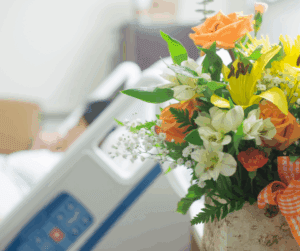
5 best flowers for people with allergies
1.Orchids
Orchids are a great option for people with allergies because they only release small amounts of sticky pollen that stays inside the flower. This means less pollen gets into the air and causes allergic reactions.
Orchids come in many colours and types, making them suitable for different preferences and places, like hospitals and homes. They are elegant and modern, adding beauty to floral arrangements while being hypoallergenic.
Even though Orchids are hypoallergenic, for some people, it’s a flower that causes an allergy, especially to those who are very sensitive to their scent. Those with strong allergies should consult a healthcare professional to identify safe flower options.
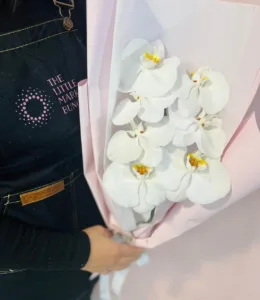
2.Roses
Fragrance-free, tight-budded red roses are hypoallergenic and make a great and safe gift for hospital patients, even if you don’t know their favourite flower. They reduce the risk of allergies or breathing problems while brightening the space. Their beauty can lift spirits and help create a positive mindset that supports healing.
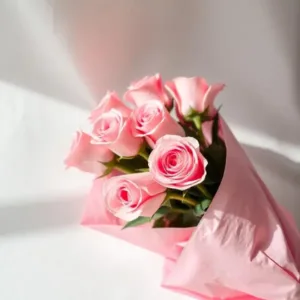
3.Hydrangeas
Say Hello to Hydrangeas, a popular choice for flower arrangements for hospitals, due to their large, attractive blooms, which are available in various colours.
Hydrangeas are a suitable choice for allergy sufferers due to their sticky pollen, which doesn’t become airborne easily, reducing the risk of triggering allergy symptoms. Their tight blooms help trap pollen, making them safe for hospitals and those with allergies.
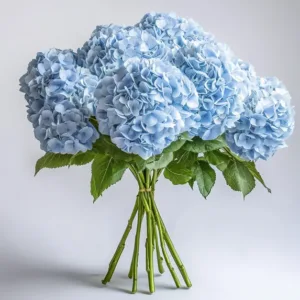
4.Tulips (Image)
Tulips are another best flower to send to patients in the hospital. They are beautiful, come in many types, and have low allergen levels. Tulips represent love and renewal, which makes them a popular choice for hospitals. Their low and sticky pollen doesn’t easily become airborne, reducing allergy concerns.
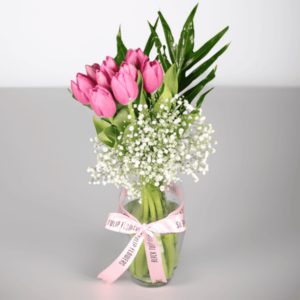
5.Carnations
- Carnations are an excellent choice for hospital patients because
- Less likely to trigger allergies compared to other flowers.
- Known to improve mood and reduce stress with their vibrant colors and fragrance.
- Can last a significant time, providing prolonged enjoyment without frequent replacements.
- Associated with love, fascination, and health, making them a thoughtful gift for recovery.
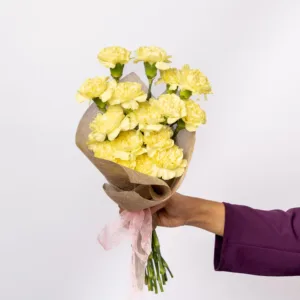
Do not order these flowers for hospital patients.
The following flowers cause allergies and are not recommended for hospital deliveries.
- Lilies
- Sunflowers
- Daisies
- Chrysanthemums.
What Color Flowers Are Best for Hospital Patients?
When sending flowers to hospital patients, color choice is key as different colors evoke various emotions. Bright colors like yellow, orange, and pink can uplift mood, while blue flowers promote relaxation. Warm hues like orange and red evoke positive feelings. Choosing flowers in the patient’s favorite colours or universally loved shades can enhance their experience.
- Yellow: Cheerful and happy
- Pink: Comforting and calm
- White: Peaceful and pure
- Lavender/Purple: Relaxing and creative
- Blue: Calm and restorative
To find the perfect arrangement, explore our shop by colour collection and choose flowers that convey just the right emotion.
When Not to Send Flowers to Patients at Hospital ?
While flowers are usually welcomed, there are instances when it’s best to avoid sending them:
- The patient is in the ICU or a sterile unit
- The hospital has a no-flower policy
- The recipient has known severe floral allergies
In such cases, consider sending:
- Fruit baskets
- Dry gift hampers
- Balloon bouquets
- Greeting cards
Check out our Fruit Bouquet for safe alternatives.
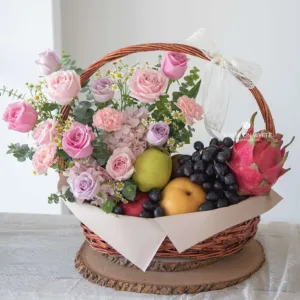
Tips to Choose the Best flowers for hospital patients
- Choose flowers that are less likely to cause allergies, like roses, carnations, or chrysanthemums.
- Before bringing them inside, check for bugs and dirt. Rinsing the flowers can help keep your room clean.
- Choose flowers with strong stems, as they need less care and last longer.
- Pick small arrangements to avoid clutter and keep important items easily reachable.
- Bright colours can make the patient feel better. Choose flowers with light scents if they are sensitive to strong smells.

Allergy-Free Hospital Flowers FAQs
Lilies, daisies, chrysanthemums, and sunflowers produce high amounts of pollen and should be avoided.
Can I send flowers to someone in the ICU?
No, most ICUs prohibit flowers to reduce infection risks and maintain air quality
Orchids, hydrangeas, and fragrance-free roses are some of the best and safest allergy-free flowers for hospital patients.
Choose a reputable local florist like Black Tulip Flowers Oman and provide detailed patient information at checkout.
Many hospitals restrict or limit flower deliveries due to allergies, infection risks, and equipment sensitivities.
seven things you need to know before you choose a special bouquet.
- Discovery Health Today reports that some hospital wards don’t allow flowers at all. If your friend or relative is in a burn unit, an intensive care ward or has a new baby, you might want to check with the hospital first to make sure that arrangements are allowed.
- Buy allergy-free flowers. Rodale.com reports that even if the recipient isn’t allergic, other visitors or hospital staff might be. “Roses, carnations and chrysanthemums are great because the pollen is inside the flower and not exposed, unlike a lily,” one florist told the news source.
- Inspect the flowers you choose for bugs and grime, which could spread to other areas of the hospital room. Give the flowers a good rinse before you take them in.
- Look for flowers with woody stems. Rodale.com reports that these types of stems won’t get soggy quickly, meaning that the hospital staff won’t have to change the water often, which can be a hassle. An arrangement in floral foam is also a good choice, as it will hold water for a while without requiring more.
- Keep the size of your flowers to a minimum. While you might think a huge arrangement will do more to cheer up your loved one, it may actually get in the way of much-needed items, reports Discovery Health Today. Instead, choose a small, front-facing vase that can be tucked against the wall.



